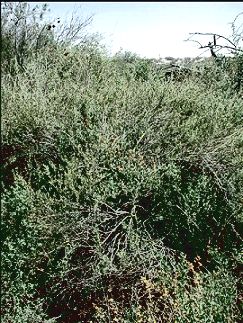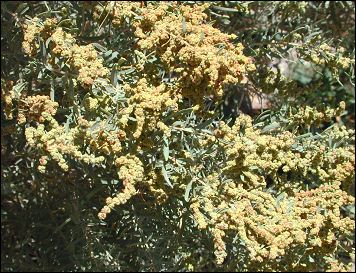

Often a family's reputation reflects the actions of its more obnoxious members. To many in western North America, Tumbleweed tarnishes the good name of the Goosefoot family of plants. But the more insightful person will forgo prejudice to seek out useful and interesting relatives. Four-wing Saltbush, or Chamiso, is a familiar, but often overlooked, jewel. But getting to know a plain sister in the family often brings its own rewards.
Among the gifts here, its extensive root system slows erosion; its seeds are edible by birds, mammals, even humans; its leaves and young shoots provide food for herbivores and soup ingredients for people; and its twigs can be used to make a yellow dye.
Like us, this plant comes in two types: male and female. Also like people, it can adapt to adversity. In saline soils, salt is shed onto the surface hairs of the leaves, crystallizing into reflective surfaces that reduce light intensity within the leaves to a tolerable level—and provide the saltbush with its name, as well.
The Goosefoot family can be proud of this plain, but versatile,
sister.

Listen to the Audio (mp3 format) as recorded by KTEP, Public Radio for the Southwest.
Contributor: Arthur H. Harris, Laboratory for Environmental Biology, University of Texas at El Paso.
Desert Diary is a joint production of the Centennial Museum and KTEP National Public Radio at the University of Texas at El Paso.


Left: Four-wing Saltbush in the Rio Grande Valley at Socorro, TX. Right: Male plant in flower; Chihuahuan Desert Gardens, 29 Jun 2001. Photographs by A.H. Harris.
Kearney, T. H., and R. H. Peebles. 1951. Arizona Flora. University of California Press, Berkeley. 1032 pp.
Wildflowers of Southern California. Good photo of flowers.
Plants of the Verde Valley and Sedona. Good pictures.